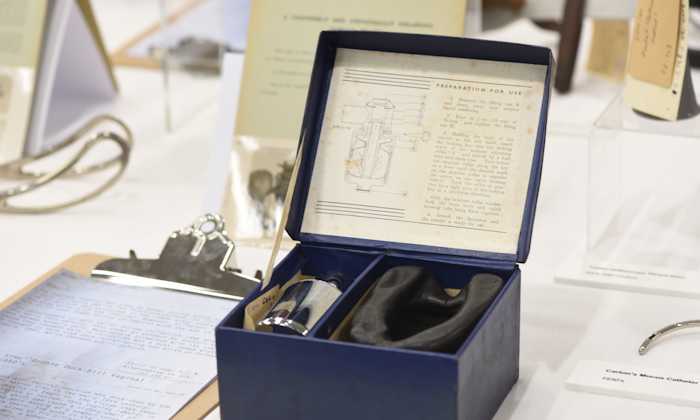‘Toils of Labour’ at International Women’s Day
13 Apr 2017
The Faculty of Biology, Medicine and Health marked International Women’s Day this year with an afternoon of activities at an “Engendering Change” event on Wednesday 8 March. As a part of this, five UoM MA Art Gallery and Museum Studies students were asked to bring Toils of Labour, an exhibition they had curated from objects in the collection of the Museum of Medicine and Health.

International Women’s Day is a global day celebrating the social, economic, cultural and political achievements of women. The day also marks a call to action for accelerating gender parity.
Held at the Roscoe Building, the event welcomed guest speakers including Susan Oliver RN FRCN, MSc, OBE, Nurse Consultant in Rheumatology and Professor Maureen Baker CBE FRCGP, Immediate past Chair of Council, Royal College of General Practitioners.
This small group of MA students from the School of Arts, Languages and Cultures – Nicholas Morris, Allison Rue, Daisy Strang, Joanna Taylor and Xue Zhang – had previously showcased their display at the Central Library, along with their peers as part of the Healing Histories exhibition in late 2016. They had been given a small number of instruments of obstetrics and gynaecology from the Museum of Medicine and Health and agreed to focus on the social history of the objects.
Toils of Labour: A Brief History of Childbirth and Women’s Health was interpretatively inclusive, communicating through professionally produced panels, ‘We are all products of childbirth’. This sensitive exhibition was considered in its labelling and explored how the objects displayed could be seen to illustrate the revolution in western medical thinking surrounding childbirth and women’s health in Europe and the USA in the 19th and early 20th centuries. At this point in history practice shifted, for example, from simply saving the life of the birthed child towards stronger acknowledgment of the importance of the mother – both before and after childbirth, as well as in daily life. This time saw the articulation of ‘gynaecology’ as a separate field of medical thought and practice.
Objects on display included a foetal stethoscope and a Sims’ Double Duck-Bill Vaginal Speculum, developed in the early 19th century to help treat tears to the tissue resulting from childbirth.
Xue Zhang, one of the students reflects on her experience
“Curating exhibition for International Women’s Day provided me with a new perspective on museum objects. The experience broadened the context and possibility to involve new audiences. I had conversations with the delegates on the day and the exhibition not only contributed to the event, but also created an informal educational setting, where both audience and I exchanged and gained knowledge.”
The Museum of Medicine and Health is a collection of over 8000 items of historic medical equipment, instruments, apparatus, photographs and archival material. Spanning over three hundred years, the collection represents a significant educational and cultural asset for the Faculty of Biology, Medicine and Health at the University of Manchester. For the past three years, the Museum of Medicine and Health has supported the work of the MA Art Gallery and Museum Studies in loaning objects from the collection to allow students hands-on experience in collections management and curating exhibitions. Aiding their professional development, the students work closely with the museum’s Heritage Officer and volunteers to research their objects and seek advice on engagement opportunities.
For enquiries contact the Museum of Medicine and Health medical.museum@manchester.ac.uk

